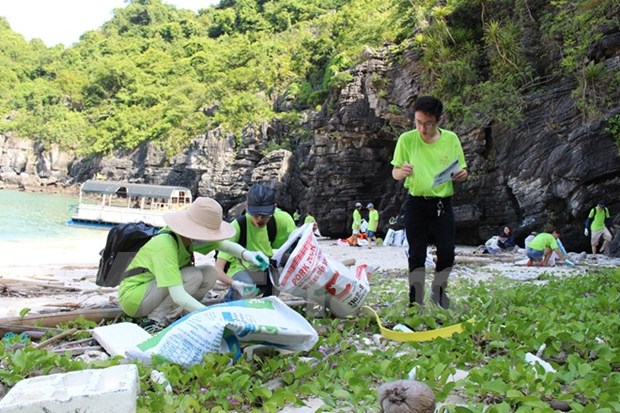Maritime pollution rings alarm bells
Establishing marine conservation areas in accordance with the national master plan on biodiversity preservation is one of the most effective ways to protect the marine environment.
 Volunteers clean beaches in islands of Ha Long Bay (Photo: VNA)
Volunteers clean beaches in islands of Ha Long Bay (Photo: VNA)According to Assoc. Prof. Dr. Nguyen Van Cu, former head of the Vietnam Administration of Seas and Islands, Vietnam aims to have 41 more marine conservation areas by 2020.
He suggested completing a framework of sea management institutions in order to exploit and use marine resources in a sustainable fashion.
Prompt actions should be taken to prevent environmental pollution and degradation at the lower reaches of rivers and coastal industrial parks and clusters, Cu said.
In a parallel effort, more attention should be paid to environmental impacts of tourism, oil exploration and exploitation, mining, aquaculture and marine facilities in 28 coastal cities and provinces nationwide, he stressed.
Scientists from the Institute of Marine Environment and Resources cited the community-base maritime resources management model, which has been rolled out in several provinces like Ninh Binh, Nam Dinh and Kien Giang, saying it is effective and economical.
Besides, by empowering locals, the model has encouraged the community to share the responsibility with the State for managing and preserving marine resources, they said.
Other jobs include raising public awareness of relevant policies and laws, and enhancing international cooperation in this regard, both bilaterally and multilaterally, especially in maritime science and technology, search and rescue, and personnel training, they noted.
Such suggestions have been made amidst the overexploitation of marine resources, pushing the maritime system, at the risk of serious pollution.
Dr. Du Van Toan from the Vietnam Administration of Seas and Islands, said most of the pollutants are sourced from the mainland, including waste water discharged by coastal cities, urban areas and industrial parks, along with oil leaked from drilling rigs and ships.
More than ten out of 100 rivers in Vietnam like the Cau, Day and Thi Vai are now seriously polluted.
All of them run to the sea, bringing with them 880 cubic kilometres of water, 270-300 million tonnes of alluvium and a large amount of pollutants, according to the Ministry of Natural Resources and Environment.
Unplanned tourism and aquaculture, plus air pollution are also blamed for maritime environmental pollution.
As a result, up to 90 percent of coral reefs in Vietnam now stand at the edge of being destroyed. The pollution also threatens about 85 types of sea creatures with 70 of them listed in Vietnam’s Red Book.-VNA













